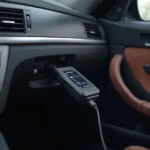Performing an OBD2 drive cycle is crucial for resetting your car’s diagnostic system and ensuring accurate emissions readings. It allows your vehicle’s onboard computer to complete specific monitoring tests, which are essential for identifying potential issues. If you’ve recently repaired your vehicle or cleared trouble codes, knowing how to perform an OBD2 drive cycle is vital for confirming the fix and preventing the check engine light from reappearing.
Understanding the OBD2 Drive Cycle
An OBD2 drive cycle is a specific series of driving conditions designed to activate all of your vehicle’s emissions monitors. These monitors continuously check various components, ensuring they are functioning within acceptable parameters. Different vehicles require different drive cycles, so it’s essential to consult your vehicle’s repair manual or use an online resource to find the correct procedure for your specific make and model. This includes certain requirements like fuel level, ambient temperature, and even the duration of the test.
Did you know that some advanced OBD2 scanners, like the ones reviewed on our bluedriver obd2 online page, can guide you through the drive cycle process? They offer real-time monitoring of readiness monitors, making the process easier and more efficient.
Performing the Generic OBD2 Drive Cycle
While specific drive cycles vary, a generic OBD2 drive cycle often serves as a good starting point. This cycle might not activate all monitors for every vehicle, but it can be effective in many cases. This generic drive cycle involves several steps:
- Cold Start: Start the engine cold (after it has been sitting for several hours).
- Idle: Let the engine idle for two minutes.
- Acceleration: Accelerate smoothly to 55 mph.
- Cruise: Maintain a steady speed of 55 mph for five minutes.
- Deceleration: Decelerate gradually without braking heavily, coming to a complete stop.
- Idle: Let the engine idle for five minutes.
- Driving in stop-and-go traffic: Drive in typical stop-and-go traffic for about 10-15 minutes, including several accelerations and decelerations.
“Following the correct drive cycle procedure is paramount for ensuring that all the necessary tests are completed and accurate diagnostic information is obtained,” advises automotive expert, John Miller, ASE Certified Master Technician.
Why is a Cold Start Important?
A cold start is essential because it allows the engine and catalytic converter to reach operating temperature, activating monitors related to these components. Skipping this step can lead to incomplete testing and potentially inaccurate results. Remember, the process may differ slightly depending on the vehicle. You can find helpful resources on using an OBD2 scanner on our using an obd2 scanner page.
How Long Does an OBD2 Drive Cycle Take?
The duration of an OBD2 drive cycle can vary, but the generic cycle usually takes between 20 and 30 minutes to complete. More complex drive cycles can take longer, sometimes requiring specific driving conditions that might be challenging to achieve in certain areas.
“Understanding your specific vehicle’s requirements is key. Don’t rely solely on generic information. Always consult your vehicle’s service manual,” recommends Sarah Johnson, Automotive Diagnostics Specialist.
Troubleshooting OBD2 Drive Cycle Issues
Sometimes, even after performing an OBD2 drive cycle, not all monitors complete. This can be due to various factors, including:
- Incorrect drive cycle: Ensure you are following the correct procedure for your specific vehicle.
- Underlying issues: If a problem persists, it could indicate an unresolved mechanical or electrical fault.
- Faulty OBD2 scanner: A malfunctioning scanner can give inaccurate readings.
For specific OBD2 code issues, like the obd2 code p0446 1999 toyota rav4, refer to our detailed guides. We also have a helpful article on the best obd2 scanner for motorcycle for motorcycle owners. Knowing your vehicle’s specific needs is essential for efficient and accurate diagnostics.
Conclusion
Performing an OBD2 drive cycle is a necessary step in diagnosing and resolving car trouble codes. By following the correct procedures, you can ensure accurate readings and confirm the effectiveness of any repairs. Remember to consult your vehicle’s specific instructions for the most accurate and efficient results. Understanding how to perform an OBD2 drive cycle empowers you to take control of your vehicle’s maintenance and ensure its optimal performance.
FAQ
- What is an OBD2 drive cycle? An OBD2 drive cycle is a series of driving conditions used to test a vehicle’s emissions system.
- Why do I need to perform a drive cycle? It’s necessary to reset the diagnostic system after repairs or clearing trouble codes.
- How long does a drive cycle take? It can vary, but generally between 20-30 minutes for a generic cycle.
- What if my monitors don’t complete? Consult your vehicle’s manual or seek professional help.
- Where can I find the correct drive cycle for my car? Your vehicle’s repair manual or reputable online resources.
- Can an OBD2 scanner help with the drive cycle? Yes, some advanced scanners can guide you through the process.
- What if I don’t follow the correct drive cycle? You might get inaccurate diagnostic readings.
Check out our article on diagrama de conector obd2 for further information.
Need assistance? Contact us via WhatsApp: +1(641)206-8880, Email: [email protected], or visit us at 789 Elm Street, San Francisco, CA 94102, USA. Our 24/7 customer support team is ready to help.
